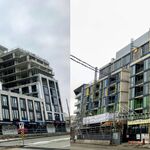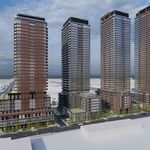Northern Light
Superstar
Many of us with, let alone those without air conditioning have been suffering through the latest heat wave.
For most people it is less the heat along than its combination with humidity that makes the temperature outside difficult and inside (without good air conditioning) intolerable.
But that is all exacerbated but one notable effect, the urban heat island.
If one looks at graphs on the Weather Network's website, one can clearly see that while daytime temps are slightly above normal; its the warm temperatures at night that lead to poor sleeping, and mean no real respite from the discomfort of the day.
The number of days over 20 degrees C at night has jumped alarmingly.
That is not a function of climate change or an anomalous warm summer.
Its a function of urban sprawl, too much pavement and too little shade.
Black surfaces, notably roads and parking lots, but many building roof systems as well, radiate heat after dark, after having absorbed sun during the day.
This is something Toronto has to address to preserve its livability
I'll put a few ideas out for discussion, but invite others, as well as how to get buy-in to tackle the problem.
1) Major roads are a huge source of the heat island effect. They are difficult to shade properly due to width.
The action plan required is that 'turning lanes' (not at lights, but the on-going ones down the middle of many suburban roads) need to come out in favour of islands with shade trees and perennial plants.
Further that boulevards must be green, provide good tree growing conditions and canopy-forming trees (no fruit trees or other short species).
2) We need to ultimately eliminate as much surface parking as possible, but in the interim, we need to create canopy over parking lots. This may mean removing up to 20% of parking spots in a large mall lot. A clear action plan is needed that addresses alternative transportation to such places and that encourages ride-sharing, carsharing, cycling, walking and transit.
3) We need to consider alternative surfaces for side streets and parking lots. The use of light-coloured interlocking pavers or compacted limestone screening would reduce the heat island effect.
4) We need to consider narrowing side streets that have ROWs greater than 7M, even if this means eliminating parking on one-side of the street. The reduced width, if replaced with a tree-lined boulevard would substantially reduce temperatures.
5) Flat roofs have to go green or cool, not just on new buildings, but existing ones, no more black.
6) Even shingles need to be re-thought, my instinct is that dark colours need to go unless there is a historical reason to preserved them.
*****
Finally, notwithstanding all of the above, I think its very important that we help people cope by increasing access to air conditioning.
In rental apartments that could mean compelling a landlord to provide at least one window unit to provide one livable room during a heat wave; or it might mean merely upgrading electrical, as I know many older apartments have only 60-amp electrical service which severely limits one's ability to install a/c even if you can afford it.
The above needs to apply to public housing as well.
We also need to adapt public swimming hours/season length to reflect the warmer weather were getting giving people a way to cool down; and complete air conditioning in public buildings, most notably schools.
Thoughts?
For most people it is less the heat along than its combination with humidity that makes the temperature outside difficult and inside (without good air conditioning) intolerable.
But that is all exacerbated but one notable effect, the urban heat island.
If one looks at graphs on the Weather Network's website, one can clearly see that while daytime temps are slightly above normal; its the warm temperatures at night that lead to poor sleeping, and mean no real respite from the discomfort of the day.
The number of days over 20 degrees C at night has jumped alarmingly.
That is not a function of climate change or an anomalous warm summer.
Its a function of urban sprawl, too much pavement and too little shade.
Black surfaces, notably roads and parking lots, but many building roof systems as well, radiate heat after dark, after having absorbed sun during the day.
This is something Toronto has to address to preserve its livability
I'll put a few ideas out for discussion, but invite others, as well as how to get buy-in to tackle the problem.
1) Major roads are a huge source of the heat island effect. They are difficult to shade properly due to width.
The action plan required is that 'turning lanes' (not at lights, but the on-going ones down the middle of many suburban roads) need to come out in favour of islands with shade trees and perennial plants.
Further that boulevards must be green, provide good tree growing conditions and canopy-forming trees (no fruit trees or other short species).
2) We need to ultimately eliminate as much surface parking as possible, but in the interim, we need to create canopy over parking lots. This may mean removing up to 20% of parking spots in a large mall lot. A clear action plan is needed that addresses alternative transportation to such places and that encourages ride-sharing, carsharing, cycling, walking and transit.
3) We need to consider alternative surfaces for side streets and parking lots. The use of light-coloured interlocking pavers or compacted limestone screening would reduce the heat island effect.
4) We need to consider narrowing side streets that have ROWs greater than 7M, even if this means eliminating parking on one-side of the street. The reduced width, if replaced with a tree-lined boulevard would substantially reduce temperatures.
5) Flat roofs have to go green or cool, not just on new buildings, but existing ones, no more black.
6) Even shingles need to be re-thought, my instinct is that dark colours need to go unless there is a historical reason to preserved them.
*****
Finally, notwithstanding all of the above, I think its very important that we help people cope by increasing access to air conditioning.
In rental apartments that could mean compelling a landlord to provide at least one window unit to provide one livable room during a heat wave; or it might mean merely upgrading electrical, as I know many older apartments have only 60-amp electrical service which severely limits one's ability to install a/c even if you can afford it.
The above needs to apply to public housing as well.
We also need to adapt public swimming hours/season length to reflect the warmer weather were getting giving people a way to cool down; and complete air conditioning in public buildings, most notably schools.
Thoughts?




